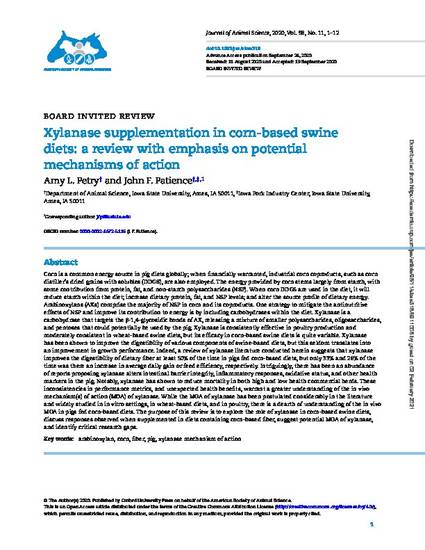
Corn is a common energy source in pig diets globally; when financially warranted, industrial corn coproducts, such as corn distiller’s dried grains with solubles (DDGS), are also employed. The energy provided by corn stems largely from starch, with some contribution from protein, fat, and non-starch polysaccharides (NSP). When corn DDGS are used in the diet, it will reduce starch within the diet; increase dietary protein, fat, and NSP levels; and alter the source profile of dietary energy. Arabinoxylans (AXs) comprise the majority of NSP in corn and its coproducts. One strategy to mitigate the antinutritive effects of NSP and improve its contribution to energy is by including carbohydrases within the diet. Xylanase is a carbohydrase that targets the β-1,4-glycosidic bonds of AX, releasing a mixture of smaller polysaccharides, oligosaccharides, and pentoses that could potentially be used by the pig. Xylanase is consistently effective in poultry production and moderately consistent in wheat-based swine diets, but its efficacy in corn-based swine diets is quite variable. Xylanase has been shown to improve the digestibility of various components of swine-based diets, but this seldom translates into an improvement in growth performance. Indeed, a review of xylanase literature conducted herein suggests that xylanase improves the digestibility of dietary fiber at least 50% of the time in pigs fed corn-based diets, but only 33% and 26% of the time was there an increase in average daily gain or feed efficiency, respectively. Intriguingly, there has been an abundance of reports proposing xylanase alters intestinal barrier integrity, inflammatory responses, oxidative status, and other health markers in the pig. Notably, xylanase has shown to reduce mortality in both high and low health commercial herds. These inconsistencies in performance metrics, and unexpected health benefits, warrant a greater understanding of the in vivo mechanism(s) of action (MOA) of xylanase. While the MOA of xylanase has been postulated considerably in the literature and widely studied in in vitro settings, in wheat-based diets, and in poultry, there is a dearth of understanding of the in vivo MOA in pigs fed corn-based diets. The purpose of this review is to explore the role of xylanase in corn-based swine diets, discuss responses observed when supplemented in diets containing corn-based fiber, suggest potential MOA of xylanase, and identify critical research gaps.
Available at: http://works.bepress.com/john-patience/80/

This article is published as Petry, Amy L., and John F. Patience. "Xylanase supplementation in corn-based swine diets: a review with emphasis on potential mechanisms of action." Journal of Animal Science 98, no. 11 (2020): skaa318. doi: 10.1093/jas/skaa318.